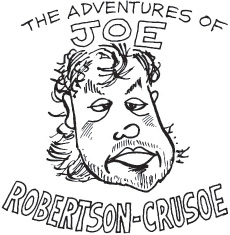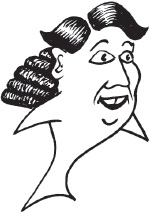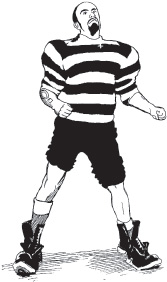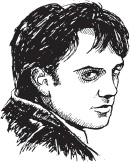
Полная версия
The Inside Story of Viz: Rude Kids
Another act Andy brought to Newcastle was a group of comedians called the Comic Strip. I’d never heard of them until I saw Andy putting up a poster in the Baltic one lunchtime around 1981. ‘They’re fucking brilliant,’ he assured me. He’d assured me A Flock of Seagulls would be fucking brilliant too, so that meant nowt. But the Comic Strip sounded promising so Jim, Simon and myself went along to see them, and thank God we did. Never in my life have I laughed so much and I doubt I’ll ever get close to it again. I was rocking in my seat, aching in the ribs and on the verge of wetting myself. Jesmond was full of social workers in Citroën 2CVs yet I’d never heard anyone (with the possible exception of my dad) make jokes about them. Alexei Sayle and 20th Century Coyote (Rik Mayall and Ade Edmondson) were the highlights. I didn’t know people could be so relentlessly, pant-pissingly funny. After the show we hung around the stage door and I pressed a copy of two Viz back issues into what looked like the hand of Jennifer Saunders. It was a very chaotic doorway.

Joe Robertson-Crusoe, from Viz issue 65, 1994
By now the idealistic Anti-Pop organization that had been such an inspiration for me and Jim was effectively no more. They’d lost a lot of steam with the departure of the Noise Toys, and now the label’s last remnants, Arthur 2 Stroke and the Chart Commandos, were also heading for obscurity. They were brilliant live and won support slots with touring acts like Ian Dury and the Blockheads and The Q Tips, but it was impossible to keep an eight-piece band on the road playing pubs and college gigs. Eventually they pawned their ambition on the local working men’s club circuit, and never got it back.
Changes were ringing down on the Quayside too. A man called Joe Robertson was in the process of transforming Newcastle nightlife with the introduction of wine bars such as Legends. Robertson had once been a swinging sixties’ DJ at the Club A-Go-Go. Now he was a successful businessman who, despite dressing like a Miami Vice drugs baron, was receiving plaudits from the police for ‘cleaning up’ the city centre. Heavy drinking and violence in and around the Bigg Market had been a huge problem in the 1970s, but now pubs and bars were going out of fashion and were being replaced by Robertson’s pseudo-sophisticated drinkeries. He’d buy a run-down pub, like the Midland Hotel for example, refit it with lots of fancy chrome and expensive lighting, and change the name to anything ending with an ‘s’. Berlins in this case. The bar would then reopen, and hundreds of young people dressed in skimpy frocks and no white socks would queue to get in and pay through the nose for fancy cocktails and bottled lagers. Robertson was shrewd, if not a slightly cheesy dresser. His genius was realizing that Geordies loved to flaunt their money. If there was a lass watching, then a bloke would much rather pay £2 for a bottle of lager than £1.20. So Joe provided £2 bottles of lager, and even costlier cocktails for the ladies. The punters lapped it up, Robertson became a millionaire and developed an accent to match the superficial refinement of his ‘hay clarse’ drinking establishments. Newcastle’s transformation into a party city had begun. By 1982 the first signs of the Quayside redevelopment were beginning to show, and it was announced that the Baltic was closing down for redevelopment. On the final night we all got pissed and drank Mackeson stout, because everything else had run out. It was the end of an era.
CHAPTER FIVE
Lunch in the Penthouse Suite
Viz’s reputation continued to spread, largely through word of mouth but also through the music press. We’d had entirely positive reviews in Zig Zag, Sounds and the NME, not to mention a two-page spread in the Loughborough Student. Jamming, a short-lived music magazine of the day, described the comic as ‘a fantastically irreverent load of shit’. In the twenty-two years since then I don’t think anyone has described it more succinctly than that.
Fanzines also provided an important method of spreading the word. By 1982 my untidy bedroom was linked to a dozen or so other untidy bedrooms across the land via a national network of fanzine editors. Many of them would ask if they could reproduce Viz cartoons in their own magazines and I’d always agree on condition that they gave the comic a plug. One such editor – a teenager in Leeds called James Brown – used a couple of Viz cartoons without permission in his magazine, Attack On Bzag. I granted him retrospective permission and in return he agreed to distribute Viz for me in Leeds. The editor of Real Shocks fanzine in Kent, a bloke called Roger Radio, also produced a comic called Cosmic Cuts. That was about the closest thing to Viz anyone else seemed to be doing, and Roger soon became a regular contributor to Viz, specializing in lazily drawn, poor-quality, one-frame jokes. Pilot: ‘Enemy plane at one o’clock!’ Gunner: ‘That’s good. We’ve got half an hour to spare then,’ for example.
By now the appearance of a new issue was so rare the event would be celebrated with a party. These ‘Viz Receptions’ began with an afternoon soirée at a hotel in Jesmond to celebrate the launch of No. 5. By the time issue 10 was published in May 1983 the venue had switched to Dingwalls, a nightclub in Waterloo Street where I’d previously had the pleasure of watching exotic dancers from Nottingham perform during a Friday lunchtime outing from the DHSS. I’d been having trouble shifting issue 9, and with 10 being a summer issue – the students were away on holiday – only 2,500 were printed. The most notable cartoon début was perhaps Billy the Fish, albeit on a rather small scale. His first strip took up only two lines at the foot of the second last page. I loved football adventure strips like Roy of the Rovers, particularly the disparity in time that always seemed to exist between the players on the field and the spectators off it. Time seemed to freeze as a shot was taken and members of the crowd would carry out lengthy conversations in the time between the ball being kicked and arriving at the goal line. The name Billy the Fish came first, a take on the Dandy’s Billy the Cat. It then occurred to me that if somebody was born half-man, half-fish, they would most likely be able to swim through the air and would therefore make a very good goalkeeper. There was a bit of a football theme to issue 10. Chris Waddle, a gangling youngster who had just broken into the Newcastle team, was a big fan of Arthur 2 Stroke and the Chart Commandos, and in order to promote their final record, a live LP, Waddle agreed to meet the band for a photo session at a pub in Gateshead. A few other players, including Terry McDermott, also turned up. I was the official photographer and took a couple of extra pictures, later making up my own story about Arthur 2 Stroke winning a music industry award after a penalty shoot-out.

Billy the Fish

Wavis O’Shave as The Hard
On the back cover there was a poster of former Anti-Pop artiste Wavis O’Shave posing as The Hard, his Tube TV character. To get the photo Simon and I visited Wavis’s house in South Shields where he lived with his mother. This was the first time I’d met him and he turned out to be a highly intelligent and articulate individual. Then he started telling us about the trouble he was having with the Greek god Pan, who had recently trotted into his living room (Pan was half-man, half-goat) through the wall next to the bay window. As Wavis explained this to us his mother came into the room with a tray of tea and biscuits. ‘Mutha. Tell them aboot Pan, how he come through that waaaall,’ he said. ‘Yes, that’s right, he did,’ said his mother, who then gave us her own description of the event, followed by the question, ‘Do either of you take sugar?’
Following Anna Ford’s Bum, Wavis recorded a second album under the name Foffo Spearjig and a single from that was released on Eccentric Records, ‘Tie Your Laces Tight’, with the brilliant B-side ‘You Won’t Catch Me on the 503’. I spent weeks designing a cover for the album, which would have been called Texican Raveloni, had it ever been released. The last time I saw Wavis was in the mid-nineties. I was sitting watching TV and suddenly there he was on Stars In Their Eyes, calling himself Callum Jensen and doing a terrific impression of Steve Harley. Unfortunately Mario Lanza won it.
The cost of printing 2,500 copies of issue 10 was £393, or around 16p each. I could sell these to shops for around 20p, making a theoretical profit of about 4p on a cover price of 30p, but it wasn’t a very healthy profit margin. Despite the fact I’d never taken a penny out of the proceeds, or paid any of the cartoonists, the comic was barely breaking even. In the autumn of 1983 my mentor, Brian from the Kard Bar, told me it was essential that I get a new issue out in time for Christmas. Realistically there was no way I could do it. I had my hands full with design work and at the rate new cartoons were being drawn a single issue was now taking six months to assemble. So Brian suggested reprinting some early back issues to satisfy growing demand and hit the Christmas market. I hastily threw together a ‘best of’ compilation of the first four issues and called it No. 10½. In order to beef it up a little, Brian had another idea. Why didn’t we give away a free pop poster with it? He had rooms full of unsold posters dating back to the early 1970s if I was interested. Brian led me through the confusing warren of dark, dusty storerooms behind and above his shop like the Phantom of the Opera leading a captive performer to his lair. We eventually arrived in a small room full of unsold Osmond posters, crates of David Cassidy key rings and sacks of Bay City Roller scarves. Fashions were short lived in the pop world and Brian had clearly had his fingers burnt on more than one occasion. He pointed out a stack of boxes which he said were T-shirts for the hugely popular ET movie. Anticipating the huge demand he’d ordered them all well in advance, before the film had been released in the UK. Unfortunately he ordered all of them in medium and large sizes, not realizing ET was going to be a strictly under-twelves phenomenon. In another corner of the room were parcels of wall posters, some of them still unopened, featuring David Cassidy, the Bay City Rollers and the Osmonds. ‘Unfortunately most of them are too big to fit inside the comic,’ said Brian, ‘unless you folded them somehow.’ ‘That’s not a problem,’ I said. ‘We can chop them into quarters.’ Quarter of a picture of the Bay City Rollers would be much funnier than the whole thing, I reckoned. So we carted the posters off to the Free Press, guillotined them, and inserted the severed remains of the seventies’ pop icons into the middle of the comics.
By 1983 I was working virtually full-time as a graphic designer. I wasn’t earning enough to make a living, but I was earning more than enough to get done for social security fraud. I wanted to go legitimate but couldn’t see how I was going to do it. Then a customer of mine, Walter, mentioned the Enterprise Allowance Scheme. Apparently the Government paid budding entrepreneurs £40 a week, for a year, to get them off the dole and into business. Walter managed a band called The Hostages and was trying to get them signed up to the scheme as well. I looked into it and discovered that I wouldn’t qualify for two reasons. Firstly, your business had to be brand new, not an existing enterprise. Secondly, your business couldn’t involve anything immoral or controversial. But what the fuck. I decided to apply anyway.
At the interview I told them I was starting up a brand new graphic design business. They didn’t seem in the least bit interested. In fact they didn’t even ask to see the documents they’d told me to bring along, one of which was a bank statement proving that I had £1000 capital to start my business with. This was the money that had gradually been accumulating from comic sales over the years, which came to around £960, topped up with a few quid from my Post Office Savings Account. I was in and out the door in a matter of seconds. They simply rubber-stamped my application, wished me good luck and called in the next budding entrepreneur. The Enterprise Allowance Scheme was often ridiculed for being a political scam to cut the dole figures, and I suppose it was. But it did actually work, albeit on the ‘throw enough shit at a wall’ principle. Fortunately I was one of the shits that stuck.
So I finally signed off the dole and became self-employed in November 1983. Two months earlier I’d written to another BBC yoof programme in response to an ad I’d seen on TV. The producers of a show called Sparks said they wanted to hear from any ‘bright young sparks’ who were involved in setting up their own small enterprises. Viz seemed like an ideal candidate for the show and a couple of weeks later a producer called Tony Matthews came up to Newcastle and met myself, Jim and Simon. He liked what he saw and the following week he wrote offering us a slot on the show. Tony said he was keen to bring some of the characters to life on TV, either by animation or using actors. He was also keen for us to have a big input into the programme. We weren’t supposed to be making the programme this time, but what Tony did was effectively give us a free hand to make our own TV commercial. Under the directorship of a girl called Alex Laird, who I think had a slightly bent nose, our little film was shot on location in Newcastle in late 1983. Jim, Simon and I were filmed drawing cartoons, talking about the characters and working at the Free Press. Simon’s acting talents came to the fore as he posed as Charlie Pontoon, our right-wing newspaper columnist, and the BBC even allowed us to hire a proper actor to play Roger Mellie. We picked a bloke called Charles Pemberton out of an actors’ sample book and the BBC Costume Department knocked up a black-and-white stripy jacket for him to wear. Sparks was a BBC Education programme, so our film had to be educational in some way, so I wrote a set of accompanying notes giving advice to any viewers who wanted to set up their own magazine.
Sparks was broadcast on 3 April 1984 at 7.05 p.m. on BBC2, and our little piece came across very well. Great credit must go to Tony Matthews and Alex Laird for capturing the spirit of the comic so well on the TV screen. Not everyone approved of the programme though. The following written complaint was received by the BBC the day after Sparks was broadcast.
Tonbridge,
Kent
3rd April 1984
Sirs
BBC2 programme at 7.05pm today (Sparks) I switched on to BBC2 just after 7 p.m. this evening to be greeted with absolute filth. What made me livid was that I could well have had my two grandchildren with me and they could easily have been tuned-in to that farrago of gutter language, etc. That apart, I myself have no wish whatsoever to see or hear such muck, and for the life of me cannot understand what sort of people now run the BBC. I noted who directed and produced this programme and that three females were also concerned with it as Production Assistants or similar. What delightful people they must all be . . .
Neither I, nor my wife, nor many of our friends, have any wish to see the sort of filth that Sparks was full of, and it’s high time your organization cleansed itself of them. No wonder our times are what they are; you bear a heavy burden of guilt, but I suppose it doesn’t really bother you.
R. H. Underwood
The programme made a more positive impression elsewhere, and while the BBC were fielding complaints I was taking a call from Bob Paynter of IPC Magazines. IPC were Britain’s biggest and best-known magazine publisher. Paynter said he’d watched the Sparks programme the night before and was intrigued. He wondered if he might see some samples of our magazine. I posted off copies of issues 9 and 10 and was on tenterhooks for the next few days wondering what his reactions would be. Eventually he rang back. How did the three of us fancy coming down to London to have lunch with his board of directors?
Paynter sent me a cheque for £276. At first I thought he wanted me to buy a car and drive down, but when I rang him he explained that this money was to cover the cost of three first-class rail fares. ‘There’s plenty more where that came from,’ he said in all seriousness. When the cheque arrived I sat and admired it for some time, then I used it to buy three saver return tickets. We pocketed the change, which came to about £60 each – the first money any of us had ever made out of Viz. We went down to London on 26 April 1984. At the time the Sun was serializing the kiss-and-tell memoirs of snooker player Tony ‘the Lancashire hot-pot’ Knowles. Jim, Simon and I rarely wrote anything together but I vividly recall writing a spoof of that on the train journey down. When we got to London we caught a tube to somewhere near the river and then walked the rest of the way, across a bridge, with me plotting our route on an A to Z. You couldn’t miss King’s Reach Tower. It was, and hopefully still is, a massive building dominating the south side of the Thames. This was the prestigious headquarters of the International Publishing Corporation. We announced our arrival at reception and a few moments later Bob Paynter came down to greet us. His overall attire – his smart green blazer in particular – made him look as if he’d just broken off from an important lawn bowls match to meet us. Paynter was in his fifties, with a greying, bouffant hairdo, and he bore an uncanny resemblance to Danny La Rue. He ushered us into a lift and told us we were going up to the Penthouse Suite to meet ‘the board’.
When the doors opened we stepped cautiously out into a vast dining suite where a host of men in suits were mingling and sipping drinks. It was like walking into a dinner party. We all looked a right state in our jeans, trainers and T-shirts. A particularly well-dressed man came towards me smiling and I went to shake his hand. He was the waiter. I ordered a glass of orange. Then I was introduced to our host, John Sanders, the Managing Director of IPC’s Youth Group. Sanders was a funny-looking bloke, a cross between Walter Matthau and Wilfrid Brambell, with what appeared to be a very expensive old lady’s wig and a facial expression that made him look like he was permanently tasting soy sauce for the very first time.
The view from the top of King’s Reach Tower was pretty impressive, due largely to the height of the building and the size of the windows. Sanders took me to one side and pointed out a selection of tiny little buildings below – London Weekend Television, the National Theatre, Waterloo Station and, finally, the headquarters of the International Monetary Fund. ‘Do you know much about the IMF?’ he asked with the enthusiasm of a man who clearly did and wanted desperately to tell someone about it. A few moments later I was saved from our one-way conversation about international monetary policy by a call to the dinner table. The table itself must have been at least six feet wide and three times as long. On one side, with our backs to the window, sat the three of us. Lined up all the way along the other side were ‘the board’, about eight of them in all. At this point Sanders, who sat in the centre facing me, formally introduced his colleagues. I can’t remember any of their names but for each one he gave a boastful, and to me entirely baffling, summary of their CV, punctuated by poignant pauses during which he smiled and we were clearly supposed to look impressed.
For lunch we had shepherd’s pie and a barrage of questions. Sanders was feeling us out, gauging our responses to various probes. ‘I don’t like the name Viz,’ he said at one point, wiping mince from the side of his mouth with a serviette. He may only have been in his fifties, but he ate like a ninety-four-year-old. I didn’t rise to the bait. After the main course Sanders got down to business. IPC were interested in the idea of a comedy magazine for students – a younger version of Private Eye, as he described it. They hadn’t got very far with the idea themselves and when they saw Viz on the telly they wondered whether we might be the people to produce it for them. They were proposing a fortnightly publication date and a twenty-four-page magazine, produced by us from a studio in Newcastle. But first of all they wanted to put us to the test. Sanders offered to pay £1,500 for a dummy issue that would have to be ready by 31 May. We agreed. Once they saw the dummy they would then decide whether or not to proceed with the plan.
After the meeting Bob Paynter gave us a brief tour of the Buster comic studio where we marvelled at some of the artwork. We asked whether it was true that they regularly reused old artwork and simply updated the wording. Our evidence for this was that we often spotted ancient vehicles in Buster cartoons – vintage lorries, cars and motorbikes. Bob told us they didn’t, all their cartoons were new, and the antique vehicles were the work of an eighty-year-old comic artist who still worked for them and didn’t get out the house very much these days. After our tour we headed out into the fresh air and back across the river. It was all a bit much to take in and we wandered across Waterloo Bridge, through Trafalgar Square and along the Mall in virtual silence before stopping for a rest in St James’s Park. I sensed a tiny bit of tension in the air and eventually Jim broke a longish silence with a question. ‘What are we going to do with the £1,500?’ Simon seconded it. I remember being furious and trying not to show it. There was me thinking, ‘How the fuck am I going to produce a twenty-four-page magazine in just one month when it currently takes six months to produce a single issue of Viz?’, and all they were thinking about was divvying up the money. I said I would use the £1,500 to finance production of the dummy, paying for materials, proper typesetting and darkroom work. Then whatever was left over we could split equally between the three of us. I could quite reasonably have demanded more as I’d be the one putting the dummy together and providing most of the cartoons, but a three-way split kept everyone happy. And, besides, I didn’t give a shit about the money. It was the daunting prospect of the dummy proving successful that was worrying me. Doing one comic by 31 May was going to require a miracle. Repeating the trick every fortnight from then on would be absolutely impossible.

Jim Brownlow
I didn’t much trust IPC, so when I got home I wrote to John Sanders asking him to confirm his offer in writing. Then I wrote again asking specifically about the copyright situation. I wanted his assurance that £1,500 was only paying for an option to buy this comic, and if they turned it down they’d have no rights to keep or use any of the material. The dummy I put together was a hotchpotch of the best of Viz to date, including a lot of material from issue 11 which had just gone to press. I redesigned old news features, had them properly typeset (in the comic I just typed the text columns on a typewriter) and obtained proper photographs to go with them from IPC’s photo library. I put in what I thought were the best of our cartoons, like Mr Logic, Big Vern and Paul Whicker, and I redrew the first episode of Billy the Fish and stretched it out to cover two pages instead of two lines. I realized I would have to spread material pretty bloody thin if Viz was ever going to be a fortnightly. At our meeting John Sanders had hinted that the political content would need to be increased so I made up a new story about a lorry driver who’d lost a consignment of cruise missiles as a token gesture not quite in that direction. I also commissioned a strip from Mick Kidd of Biff, later of Guardian fame, who had been a Viz distributor, as opposed to contributor, in London at the time.




